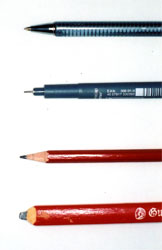
NEW March 2007
Marking Tools
Go to Main Menu
Return to Tools Index
Introduction
Marking timber requires the use of a
pencil. Do not use a ball pen or felt tip marker. The pressure exerted by the
ball pen will leave a groove in the timber that would require considerable sanding to
remove. Ink from both a ball pen and felt tip soaks into the timber fibres, spreading at
the same time again demading excessive sanding to remove.
Pencils
Pencils come in a variety of types, from the large carpenter's pencil to expensive draughting
implements. While the carpenter's pencil is obviously unsuitable for making fine lines, the
"standard" wood pencil is also far from ideal. To draw a fine line, the tip must be sharp
and as the lead wears down it will require sharpening. This task soon becomes a bore and will
result in using a blunt pencil - leading to thick lines and inaccurate sawing.
Recommended
The ideal pencil is a mechanical (claw, propelling) type. Some versions are very expensive but
cheaper makes are available and suitable. These can be obtained in 0.7mm and 0.5mm sizes
with a range of lead densities. My preference is for 0.5mm and HB or B leads.
Sharpening?
The professional method of sharpening these leads is to rub them along a sandpaper block but
I find that the 0.5mm lead is virtually self-sharpening, especially if it is rotated
when drawing a line.

 |
Claw pencil |
 |
Felt tip pen |
 |
"Standard" wooden pencil |
 |
Carpenter's pencil |
Go to top of Page
© 2007 Neil Helsby